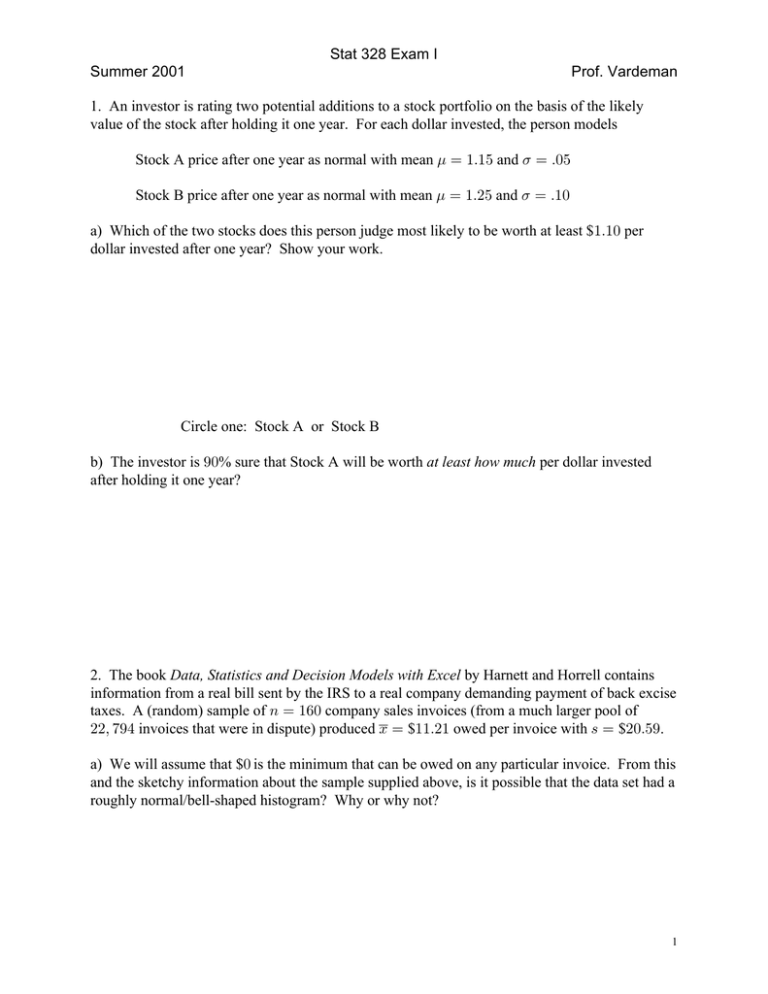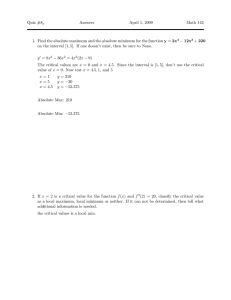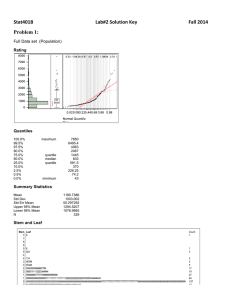Stat 328 Exam I Summer 2001 Prof. Vardeman
advertisement

Stat 328 Exam I Summer 2001 Prof. Vardeman 1. An investor is rating two potential additions to a stock portfolio on the basis of the likely value of the stock after holding it one year. For each dollar invested, the person models Stock A price after one year as normal with mean . œ "Þ"& and 5 œ Þ!& Stock B price after one year as normal with mean . œ "Þ#& and 5 œ Þ"! a) Which of the two stocks does this person judge most likely to be worth at least $"Þ"! per dollar invested after one year? Show your work. Circle one: Stock A or Stock B b) The investor is *!% sure that Stock A will be worth at least how much per dollar invested after holding it one year? 2. The book Data, Statistics and Decision Models with Excel by Harnett and Horrell contains information from a real bill sent by the IRS to a real company demanding payment of back excise taxes. A (random) sample of 8 œ "'! company sales invoices (from a much larger pool of ##ß (*% invoices that were in dispute) produced B œ $""Þ#" owed per invoice with = œ $#!Þ&*. a) We will assume that $! is the minimum that can be owed on any particular invoice. From this and the sketchy information about the sample supplied above, is it possible that the data set had a roughly normal/bell-shaped histogram? Why or why not? 1 b) Give approximate 90% confidence limits for the mean excise tax owed per invoice. c) Does the validity of your answer in b) depend upon the 22,794 invoices having a normal relative frequency distribution of excise tax owed? Explain. d) Apparently, the bill sent to the company was for $"*%ß '%(, or about $)Þ&% per invoice. Put yourself in the position of an IRS supervisor. The sample mean ($""Þ#") is substantially larger than the amount billed. Should you be convinced that the $)Þ&% was clearly too low (and that your agents should clearly have sent a larger bill)? (Show appropriate null and alternative hypotheses and report an appropriate :-value.) 3. Attached to this exam is a JMP report for the analysis of some data from 8 œ '& case files from an income tax preparation company. Represented are values of and also ÈC . C œ deductions claimed a) Describe the shape of the C distribution in "! words or less. 2 b) Using the scale below, make a boxplot for the deduction data. +-+-+-+-+-+-+-+-+-+-+-+-+-+-+-+-+-+-+-+-+0 5000 10,000 15,000 20,000 c) Ignore the graduated nature of the income tax and suppose that each deduction dollar produces $.28 worth of reduction in tax owed. That is, consider the quantity B œ Þ#)C What are the mean and standard deviation of B? B œ __________ =B œ __________ d) The first histogram suggests that using the raw deduction data, C, one should probably NOT use the formula from class to make a prediction interval for Cnew Þ But in this regard, the second histogram looks "better" than the first. Use the second part of the JMP report and make a *&% prediction interval for ÐÈCÑnew . Then square the end points of your interval to get a prediction interval for a single additional deduction value. interval for an additional ÈC À interval for an additional C from the above: 3 Distributions DEDUCTS Quantiles 0 5000 10000 15000 20000 100.0% maximum 99.5% 97.5% 90.0% quartile 75.0% median 50.0% quartile 25.0% 10.0% 2.5% 0.5% 0.0% minimum Moments 20701 20701 17844 8402 6750 5450 3650 3250 938 888 888 Mean Std Dev Std Err Mean upper 95% Mean lower 95% Mean N 5791.385 3097.026 384.139 6558.791 5023.978 65.000 Root(DEDUCTS) Quantiles 20 30 40 50 60 70 80 90 100 110 120 130140 150 100.0% maximum 99.5% 97.5% 90.0% 75.0% quartile 50.0% median 25.0% quartile 10.0% 2.5% 0.5% 0.0% minimum Moments 143.88 143.88 133.36 91.66 82.16 73.82 60.32 57.01 30.62 29.80 29.80 Mean Std Dev Std Err Mean upper 95% Mean lower 95% Mean N 73.87286 18.42299 2.28509 78.43786 69.30786 65.00000 4






